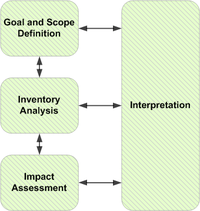
Photo from wikipedia
A comparative cradle-to-grave life cycle assessment (LCA) of a low-impact-development (LID) parking lot test-site is performed to quantify the environmental costs of the manufacturing, construction, transportation, operation, maintenance and decommissioning… Click to show full abstract
A comparative cradle-to-grave life cycle assessment (LCA) of a low-impact-development (LID) parking lot test-site is performed to quantify the environmental costs of the manufacturing, construction, transportation, operation, maintenance and decommissioning of three bioretention cells and three permeable pavement systems (PPS) located in Mississauga, Ontario, as well as a hypothetical stormwater management pond. The LIDs' influent and effluent water quality and volume data is used to quantify the environmental benefits offered by the LIDs. Ecoinvent v3 LCA database is utilized to create an inventory of the materials and energy used during the life cycle of the LIDs. Using TRACI 2.1 impact assessment method, an LCA is conducted to simulate impacts on ten midpoint categories using a functional unit of "1 m2 of impervious area treated". It has been found that manufacturing of raw materials has the largest impact (∼50%) on ozone depletion, global warming, smog potential, acidification, carcinogenic emissions, respiratory effects and fossil fuel depletion. The LIDs offer a significant avoidance of eutrophication potential, non-carcinogenic emissions and ecotoxicity, which are all mostly associated with the water quality benefits offered by the LIDs. The bioretention impacts are ∼90% lower than the PPS' on a "per 1 m2 of impervious area treated" basis due to its larger impervious area treatment relative to its size compared to the PPS. The benefits offered by bioretention are significantly higher on "per 1 m2 LID area" basis (∼12x), but comparable on "per 1 m2 impervious area treated" basis. The impacts normalized by per-capita emissions in Canada in the year 2005 show that the negative impacts of the LIDs are insignificant compared to the benefits they provide. A comparison of the LIDs to a traditional pipe-and-pond infrastructure of an equivalent treatment capacity reveals that the cradle-to-grave impacts of LIDs are ∼20% lower compared to the detention pond's, and the benefits accrued by the LIDs are ∼300% higher compared to the detention pond, making a strong case for the selection of LIDs over traditional stormwater management practices.
Journal Title: Journal of environmental management
Year Published: 2019
Link to full text (if available)
Share on Social Media: Sign Up to like & get
recommendations!